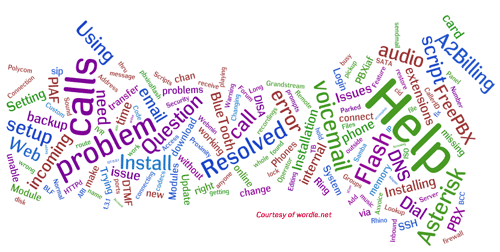
Whenever we tackle a new VoIP platform especially for deployment on the open Internet, we think it’s prudent to circle back after a few weeks to review lessons learned and tie up all the loose ends. Today we’ll introduce a number of new KVM cloud providers around the globe at rock-bottom prices plus some new additions to enhance our OpenSIPS firewall design. If you’re just getting started with OpenSIPS, check out the new KVM offerings below and then hop over to our original article which now incorporates all of today’s enhancements. For those that already have deployed OpenSIPS using our previous tutorial, continue reading, and we’ll show you how to deploy the latest and greatest additions.
While we were in the midst of deploying OpenSIPS, Netflix also disclosed four TCP networking kernel vulnerabilities which are especially important to those of us using hosted cloud platforms. Depending upon your provider, these may or may not be patched promptly.
We were reminded this month that reinventing the wheel isn’t always the best solution when it comes to VoIP security. While we’re not throwing in the towel on our BadGuys list, we do want to show you how to supplement it with the VoIP Blacklist from voipbl.org. It adds over 80,000 crowd-sourced IP addresses from around the world. The other lesson learned was that blacklists invariably include some IP addresses of good guys that you actually depend upon. These typically are added to the blacklist by, you guessed it, the bad guys.
With IPtables, the first matching rule always wins so it’s important in structuring firewall rules to insert whitelisted IP addresses BEFORE the blacklist entries so you don’t inadvertently block yourself or some other resource that you actually need. This whitelist should include the IP addresses of your server and workstations as well as the IP addresses of VoIP providers upon whom you rely for communications services. With our OpenSIPS design, the firewall order of preference looks like this: (1) whitelisted IP addresses get full access, (2) blacklisted IP addresses are blocked and get no access, (3) everybody else gets SIP access.
Rather than attempting to patch the Linux kernel on all of the platforms that are being deployed, we think the prudent first step is to narrow the TCP footprint of all public-facing servers. As part of the original OpenSIPS deployment, we already had hidden web access behind the firewall except for specifically enumerated IP addresses. The second most likely TCP vulnerability would be the TCP SIP ports. While we prefer to use UDP ports for SIP access, some prefer TCP. Until the “SACK Panic” vulnerability is patched, we would strongly recommend at least temporarily discontinuing use of TCP as your SIP transport. After all, OpenSIPS is a SIP server, and the TCP SIP port would be the most likely target for mischief.
Turning back to blacklists for a moment, we’ve put together a few simple bash scripts which make it easy to deploy and update your VoIP blacklists. We’ve also developed a script that lets you move IP addresses flagged by Fail2Ban into the ipset SIPFLOOD blacklist while easing the pain of uploading your own blacklisted IP addresses to the voipbl.org site for inclusion in their list. In this way, they will be added in the next day’s blacklist collection for everyone to use. To give you a point of reference, on our half dozen, publicly-exposed honey pot servers, today’s additions to the OpenSIPS firewall have reduced attacks to less than one a day.
Choosing a KVM Platform for OpenSIPS
For those that are frequent visitors, you already know that we’ve been pushing everyone to kiss their local hardware goodbye and join the cloud revolution. When it comes to public-facing VoIP platforms like OpenSIPS, most of us don’t have a choice. You need a static IP address on the open Internet. And, for the sake of security, a KVM cloud platform is a must since OpenVZ platforms don’t support the ipset component of IPtables which makes it easy to block hundreds of thousands of IP addresses without a performance hit on your server. While we previously have identified OpenVZ providers for our Incredible PBX platforms protected by the Travelin’ Man 3 firewall, pure whitelist access simply isn’t an option if you wish to retain the functionality of a VoIP application such as OpenSIPS. So we went on the hunt to identify KVM cloud providers around the world that could offer a KVM VPS with 1GB RAM, 20GB storage, and 1TB of monthly bandwidth for about $25 a year. No small feat! But our friends at LowEndTalk have come through. Read the message thread and find an offer with a site that best meets your requirements. Many of the KVM offers require you to open a ticket to get the special pricing and configuration outlined above. Here’s a short list of our favorites, but remember to only use the KVM offerings below for OpenSIPS!
| Provider | RAM | Disk | Bandwidth | Performance as of 12/1/19 | Cost |
|---|---|---|---|---|---|
| CrownCloud KVM (LA) | 1GB | 20GB + Snapshot | 1TB/month | 598Mb/DN 281Mb/UP 2CPU Core | $25/year Best Buy! |
| Naranjatech KVM (The Netherlands) | 1GB | 20GB | 1TB/month | Hosting since 2005 VAT: EU res. | 20€/year w/code: SBF2019 |
| BudgetNode KVM (LA) | 1GB | 40GB RAID10 | 1TB/month | Also available in U.K PM @Ishaq on LET before payment | $24/year |
| FreeRangeCloud KVM (Ashburn VA, Winnipeg, Freemont CA) | 1GB | 20GB SSD | 3TB/month | Pick EGG loc'n Open ticket for last 5GB SSD | $30/year w/code: LEBEGG30 |
Introducing the VoIP Blacklist
We’ve always dreamed of an effective VoIP Blacklist, and many have tried. But the crowd-sourced VoIP Blacklist at voipbl.org is the real deal. Everybody can post entries (including the bad guys) and, magically, most of the illegitimate entries get sifted out before the next day’s list is released. We’ve made this easy in two ways. First, the list gets populated every night while you sleep. At last count, there were 84,504 IP addresses. And, second, to contribute to the blacklist, run iptables -nL weekly to see if Fail2Ban has snagged any bad guys. If so, simply run the new /root/blacklist utility which will move them into your local blacklist and also format the entries for easy submission to voip.bl whenever you feel the urge. Simply issue the command cat /root/blcklist.txt to display the entries you just blacklisted. Then cut-and-paste the results and post them to the VoIP Blacklist. The whole process takes less than a minute, and you’ll be contributing to a very valuable VoIP resource while also using it.
Upgrading Existing OpenSIPS KVM/OVZ7 Platforms
If you already have installed OpenSIPS using the previous Nerd Vittles tutorial on a KVM or OVZ7 platform, then the rest of today’s article is for you. If you’re just getting started, hop over to our original article which now incorporates all of today’s enhancements including the VoIP Blacklist.
We’ve made today’s upgrade easy. Just download the OpenSIPS upgrade tarball, untar it, and run the included installer. In less than a minute, you’ll have all the new pieces without disturbing your existing configuration.
To get started, log into your KVM or OVZ7 server as root using SSH or Putty and issue these commands:
cd / wget http://incrediblepbx.com/opensips-upgrade1.tar.gz tar zxvf opensips-upgrade1.tar.gz rm -f opensips-upgrade1.tar.gz /root/opensips-upgrade1
Originally published: Monday, June 24, 2019

Need help with Asterisk? Visit the VoIP-info Forum.
Special Thanks to Our Generous Sponsors
FULL DISCLOSURE: ClearlyIP, Skyetel, Vitelity, DigitalOcean, Vultr, VoIP.ms, 3CX, Sangoma, TelecomsXchange and VitalPBX have provided financial support to Nerd Vittles and our open source projects through advertising, referral revenue, and/or merchandise. As an Amazon Associate and Best Buy Affiliate, we also earn from qualifying purchases. We’ve chosen these providers not the other way around. Our decisions are based upon their corporate reputation and the quality of their offerings and pricing. Our recommendations regarding technology are reached without regard to financial compensation except in situations in which comparable products at comparable pricing are available from multiple sources. In this limited case, we support our sponsors because our sponsors support us.
 BOGO Bonaza: Enjoy state-of-the-art VoIP service with a $10 credit and half-price SIP service on up to $500 of Skyetel trunking with free number porting when you fund your Skyetel account. No limits on number of simultaneous calls. Quadruple data center redundancy. $25 monthly minimum spend required. Tutorial and sign up details are here.
BOGO Bonaza: Enjoy state-of-the-art VoIP service with a $10 credit and half-price SIP service on up to $500 of Skyetel trunking with free number porting when you fund your Skyetel account. No limits on number of simultaneous calls. Quadruple data center redundancy. $25 monthly minimum spend required. Tutorial and sign up details are here.
 The lynchpin of Incredible PBX 2020 and beyond is ClearlyIP components which bring management of FreePBX modules and SIP phone integration to a level never before available with any other Asterisk distribution. And now you can configure and reconfigure your new Incredible PBX phones from the convenience of the Incredible PBX GUI.
The lynchpin of Incredible PBX 2020 and beyond is ClearlyIP components which bring management of FreePBX modules and SIP phone integration to a level never before available with any other Asterisk distribution. And now you can configure and reconfigure your new Incredible PBX phones from the convenience of the Incredible PBX GUI.
 VitalPBX is perhaps the fastest-growing PBX offering based upon Asterisk with an installed presence in more than 100 countries worldwide. VitalPBX has generously provided a customized White Label version of Incredible PBX tailored for use with all Incredible PBX and VitalPBX custom applications. Follow this link for a free test drive!
VitalPBX is perhaps the fastest-growing PBX offering based upon Asterisk with an installed presence in more than 100 countries worldwide. VitalPBX has generously provided a customized White Label version of Incredible PBX tailored for use with all Incredible PBX and VitalPBX custom applications. Follow this link for a free test drive!
 Special Thanks to Vitelity. Vitelity is now Voyant Communications and has halted new registrations for the time being. Our special thanks to Vitelity for their unwavering financial support over many years and to the many Nerd Vittles readers who continue to enjoy the benefits of their service offerings. We will keep everyone posted on further developments.
Special Thanks to Vitelity. Vitelity is now Voyant Communications and has halted new registrations for the time being. Our special thanks to Vitelity for their unwavering financial support over many years and to the many Nerd Vittles readers who continue to enjoy the benefits of their service offerings. We will keep everyone posted on further developments.

